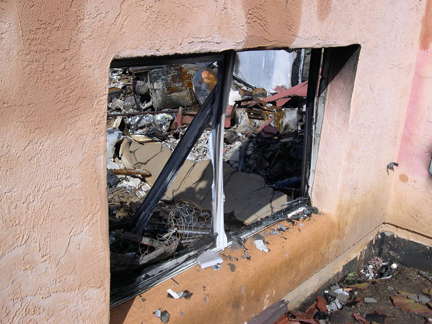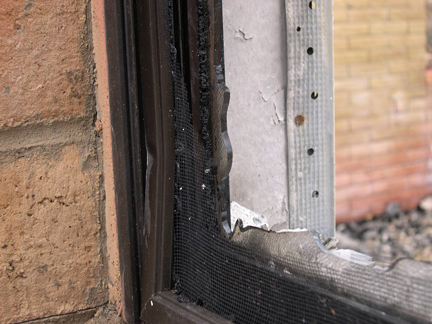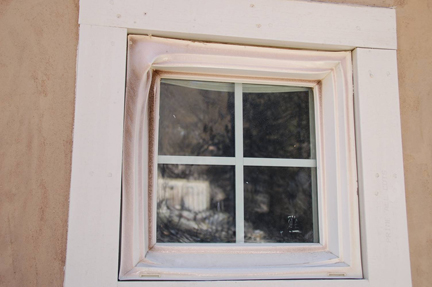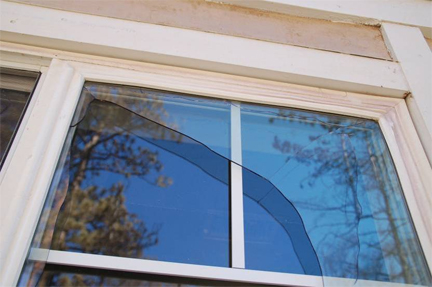Windows vulnerabilities

Wildfires can spread from the outside to the inside of buildings when windows break. Glass, the most vulnerable part of the window, can break when exposed to extreme heat, either radiant or from flame contact, or when wind-blown debris impacts the window. Whether a window's glass breaks (or combustible siding ignites) will also depend on the exposure time. A multi-pane window can perform significantly better when equipped with tempered glass, which is much more resistant than annealed (regular) glass. If the glass is tempered, you can find a small label in a corner of the window. Some level of debris and heat protection would be provided by shutters.

In vinyl windows with separators (interlocks), gaps can develop between the separator and the glass unit at low radiant exposures. As a result, embers or flames may enter the building through these gaps. Studies have shown that this deformation won't occur if the separator has an aluminum cross piece (inner). These reinforcement members are often included in vinyl windows for a variety of reasons (for example, to resist wind loads, allow hardware attachment, or to prevent break-ins).
Examples of window failures

|
Dual pane window in a fire. Radiant exposure resulted in the failure of this window, including both pieces of glass, and the vinyl clad screen. The length of exposure to the heat is an important factor to prevent the failure of the window. |

|
Vinyl frame. The vinyl deformed as a result of a radiant exposure from a neighboring home that had ignited and was ultimately destroyed. The glass did not break, or fall out as a result of the deformation in the vinyl frame. |

|
Double pane annealed glass window. Photograph after a 2007 wildfire in the Lake Arrowhead area. The outer pane broke under radiant exposure from a neighbor's house that burned down. The window was dual pane with a vinyl frame. Both panes contained (regular) annealed glass. |
How can you protect your windows?
In general, windows (and doors with glass panels) should be protected from prolonged exposure to radiant heat and flames.
- It is recommended that single pane windows be replaced with double pane windows (one tempered pane would improve fire resistance)
- To prevent long-term flame exposure and possible ember entry, vegetation should be removed near the windows
- If your home is within 30 feet of a neighbor's home or building, consider installing shutters
- If you have vinyl windows, confirm there is a vertical or horizontal reinforcement bar
- Before evacuation, close all windows and skylights as a fire approaches to prevent ember entry. If you have time, cover your windows with plywood panels
California regulations
Chapter 7A of the California Building Code allows the use of any framing material. Glass in a window can comply in any one of the following ways:
- By being part of an insulating glass unit with a minimum of one pane being tempered glass. The tempered member can be either the inner or outer pane, or
- Be constructed of glass block units, or
- Have a fire-resistance rating of not less than 20 minutes (test NFPA 257), or
- Meet the performance requirements of SFM Standard test method 12-7A-2
The first two options for compliance are prescriptive. Currently, building code requires tempered glass for windows in or immediately adjacent to doors, and in windows that are 18' or less from a floor. Chapter 7A requires one of the panes in all dual pane windows to be tempered.
The third and fourth options are performance tests. During these tests, a window is subjected to a radiant heat flux or a flame impingement exposure.
Products and assemblies that have complied with Chapter 7A can be found in the WUI Product Handbook. Since “ignition resistant” and “non-combustible” are performance-based characteristics (i.e., there is a standard test to show compliance), these materials are included in the Handbook.
Check out these additional wildfire preparedness resources from UC ANR Fire Network Members and our colleagues!
Home Hardening